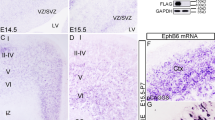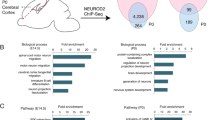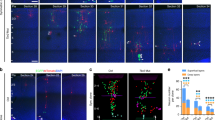Abstract
Mechanisms controlling brain size include the regulation of neural progenitor cell proliferation, differentiation, survival and migration1,2. Here we show that ephrin-A/EphA receptor signalling plays a key role in controlling the size of the mouse cerebral cortex by regulating cortical progenitor cell apoptosis. In vivo gain of EphA receptor function, achieved through ectopic expression of ephrin-A5 in early cortical progenitors expressing EphA7, caused a transient wave of neural progenitor cell apoptosis, resulting in premature depletion of progenitors and a subsequent dramatic decrease in cortical size. In vitro treatment with soluble ephrin-A ligands similarly induced the rapid death of cultured dissociated cortical progenitors in a caspase-3-dependent manner, thereby confirming a direct effect of ephrin/Eph signalling on apoptotic cascades. Conversely, in vivo loss of EphA function, achieved through EphA7 gene disruption, caused a reduction in apoptosis occurring normally in forebrain neural progenitors, resulting in an increase in cortical size and, in extreme cases, exencephalic forebrain overgrowth. Together, these results identify ephrin/Eph signalling as a physiological trigger for apoptosis that can alter brain size and shape by regulating the number of neural progenitors.
This is a preview of subscription content, access via your institution
Access options
Subscribe to this journal
Receive 51 print issues and online access
$199.00 per year
only $3.90 per issue
Buy this article
- Purchase on Springer Link
- Instant access to full article PDF
Prices may be subject to local taxes which are calculated during checkout




Similar content being viewed by others
References
Caviness, V. S. Jr, Takahashi, T. & Nowakowski, R. S. Numbers, time and neocortical neuronogenesis: a general developmental and evolutionary model. Trends Neurosci. 18, 379–383 (1995)
Mochida, G. H. & Walsh, C. A. Molecular genetics of human microcephaly. Curr. Opin. Neurol. 14, 151–156 (2001)
Flanagan, J. G. & Vanderhaeghen, P. The ephrins and Eph receptors in neural development. Annu. Rev. Neurosci. 21, 309–345 (1998)
Klein, R. Eph/ephrin signaling in morphogenesis, neural development and plasticity. Curr. Opin. Cell Biol. 16, 580–589 (2004)
Poliakov, A., Cotrina, M. & Wilkinson, D. G. Diverse roles of eph receptors and ephrins in the regulation of cell migration and tissue assembly. Dev. Cell 7, 465–480 (2004)
Yun, M. E., Johnson, R. R., Antic, A. & Donoghue, M. J. EphA family gene expression in the developing mouse neocortex: regional patterns reveal intrinsic programs and extrinsic influence. J. Comp. Neurol. 456, 203–216 (2003)
Chaveroche, M. K., Ghigo, J. M. & d'Enfert, C. A rapid method for efficient gene replacement in the filamentous fungus Aspergillus nidulans. Nucleic Acids Res. 28, E97 (2000)
Zhang, Y., Muyrers, J. P., Testa, G. & Stewart, A. F. DNA cloning by homologous recombination in Escherichia coli. Nature Biotechnol. 18, 1314–1317 (2000)
Gorski, J. A. et al. Cortical excitatory neurons and glia, but not GABAergic neurons, are produced in the Emx1-expressing lineage. J. Neurosci. 22, 6309–6314 (2002)
Chenn, A. & Walsh, C. A. Regulation of cerebral cortical size by control of cell cycle exit in neural precursors. Science 297, 365–369 (2002)
Kuan, C. Y., Roth, K. A., Flavell, R. A. & Rakic, P. Mechanisms of programmed cell death in the developing brain. Trends Neurosci. 23, 291–297 (2000)
Kuida, K. et al. Decreased apoptosis in the brain and premature lethality in CPP32-deficient mice. Nature 384, 368–372 (1996)
Dufour, A. et al. Area specificity and topography of thalamocortical projections are controlled by ephrin/Eph genes. Neuron 39, 453–465 (2003)
Wilkie, A. L., Jordan, S. A., Sharpe, J. A., Price, D. J. & Jackson, I. J. Widespread tangential dispersion and extensive cell death during early neurogenesis in the mouse neocortex. Dev. Biol. 267, 109–118 (2004)
Thomaidou, D., Mione, M. C., Cavanagh, J. F. & Parnavelas, J. G. Apoptosis and its relation to the cell cycle in the developing cerebral cortex. J. Neurosci. 17, 1075–1085 (1997)
Dorus, S. et al. Accelerated evolution of nervous system genes in the origin of Homo sapiens. Cell 119, 1027–1040 (2004)
Bello, B. C., Hirth, F. & Gould, A. P. A pulse of the Drosophila Hox protein Abdominal-A schedules the end of neural proliferation via neuroblast apoptosis. Neuron 37, 209–219 (2003)
Dohn, M., Jiang, J. & Chen, X. Receptor tyrosine kinase EphA2 is regulated by p53-family proteins and induces apoptosis. Oncogene 20, 6503–6515 (2001)
Yue, Y. et al. Selective inhibition of spinal cord neurite outgrowth and cell survival by the Eph family ligand ephrin-A5. J. Neurosci. 19, 10026–10035 (1999)
Campbell, D. S. & Holt, C. E. Apoptotic pathway and MAPKs differentially regulate chemotropic responses of retinal growth cones. Neuron 37, 939–952 (2003)
Geisbrecht, E. R. & Montell, D. J. A role for Drosophila IAP1-mediated caspase inhibition in Rac-dependent cell migration. Cell 118, 111–125 (2004)
Bagnard, D. et al. Semaphorin 3A-vascular endothelial growth factor-165 balance mediates migration and apoptosis of neural progenitor cells by the recruitment of shared receptor. J. Neurosci. 21, 3332–3341 (2001)
Thiebault, K. et al. The netrin-1 receptors UNC5H are putative tumor suppressors controlling cell death commitment. Proc. Natl Acad. Sci. USA 100, 4173–4178 (2003)
Williams, M. E., Strickland, P., Watanabe, K. & Hinck, L. UNC5H1 induces apoptosis via its juxtamembrane region through an interaction with NRAGE. J. Biol. Chem. 278, 17483–17490 (2003)
Matsunaga, E. et al. RGM and its receptor neogenin regulate neuronal survival. Nature Cell Biol. 6, 749–755 (2004)
Mazelin, L. et al. Netrin-1 controls colorectal tumorigenesis by regulating apoptosis. Nature 431, 80–84 (2004)
Raoul, C., Pettmann, B. & Henderson, C. E. Active killing of neurons during development and following stress: a role for p75(NTR) and Fas? Curr. Opin. Neurobiol. 10, 111–117 (2000)
Lee, R., Kermani, P., Teng, K. K. & Hempstead, B. L. Regulation of cell survival by secreted proneurotrophins. Science 294, 1945–1948 (2001)
Holmberg, J. et al. Ephrin-A2 reverse signaling negatively regulates neural progenitor proliferation and neurogenesis. Genes Dev. 19, 462–471 (2005)
Vanderhaeghen, P. et al. A mapping label required for normal scale of body representation in the cortex. Nature Neurosci. 3, 358–365 (2000)
Acknowledgements
We thank G. Vassart for continuous support and interest, and members of IRIBHM for help and advice, in particular D. Communi, N. Gaspard, M.-A. Lambot, S. Pietri, J. Seibt and F. Pauwels. We also thank the Development Studies Hybridoma Bank; T. Ciossek for sharing the EphA7 mutant mice; C. d'Enfert and J.-M. Ghigo for the gift of the pKOBEGA plasmid; A. de Kerchove for discussions about BAC recombineering; A. Deplano for help with pulse-field electrophoresis; S. Tajbakhsh for the gift of the floxed eGFP cassette; F. Stewart for the gift of the frt-Neo cassette and the 294-Flp bacteria; A. Goffinet for the gift of mouse reelin plasmid; R. Hevner for the gift of Tbr1 antibody; and F. Polleux for critically reading the manuscript. This work was funded by grants from the Belgian Funds for Scientific Research (FNRS and FRSM), the Belgian Queen Elizabeth Medical Foundation, the Belgian Interuniversity Attraction Poles Programme (to P.V.), and grants from the American Cancer Society and National Institutes of Health (to K.R.J). P.V. and C.L. are Research Associates, and L.P. is a Research Fellow, of the FNRS. A.D. and V.D. were supported by the Fonds pour la Recherche en Industrie et Agriculture (FRIA).
Author information
Authors and Affiliations
Corresponding author
Ethics declarations
Competing interests
Reprints and permissions information is available at npg.nature.com/reprintsandpermissions. The authors declare no competing financial interests.
Supplementary information
Supplementary Methods
Additional details of the generation of TGA7A5 BAC transgenic mice and immunohistochemistry techniques used in this study. (DOC 26 kb)
Supplementary Figure S1
Analysis of neural specification in TG/Emx1-Cre mutants. (PDF 388 kb)
Supplementary Figure S2
Analysis of neural specification in EphA7 -/- mutants. (PDF 398 kb)
Supplementary Figure S3
Patterns of expression of ephrin-A2, ephrin-A3, ephrin-A5 and EphA7 in the early mouse forebrain. (PDF 241 kb)
Supplementary Legends
Legends to accompany the above Supplementary Figures. (DOC 25 kb)
Rights and permissions
About this article
Cite this article
Depaepe, V., Suarez-Gonzalez, N., Dufour, A. et al. Ephrin signalling controls brain size by regulating apoptosis of neural progenitors. Nature 435, 1244–1250 (2005). https://doi.org/10.1038/nature03651
Received:
Accepted:
Published:
Issue Date:
DOI: https://doi.org/10.1038/nature03651
This article is cited by
-
Deciphering the roles of glycogen synthase kinase 3 (GSK3) in the treatment of autism spectrum disorder and related syndromes
Molecular Biology Reports (2021)
-
Nogo-A-Δ20/EphA4 interaction antagonizes apoptosis of neural stem cells by integrating p38 and JNK MAPK signaling
Journal of Molecular Histology (2021)
-
Ephrin-B2 paces neuronal production in the developing neocortex
BMC Developmental Biology (2020)
-
Zfp422 promotes skeletal muscle differentiation by regulating EphA7 to induce appropriate myoblast apoptosis
Cell Death & Differentiation (2020)
-
The clinical benefit of array-based comparative genomic hybridization for detection of copy number variants in Czech children with intellectual disability and developmental delay
BMC Medical Genomics (2019)
Comments
By submitting a comment you agree to abide by our Terms and Community Guidelines. If you find something abusive or that does not comply with our terms or guidelines please flag it as inappropriate.



